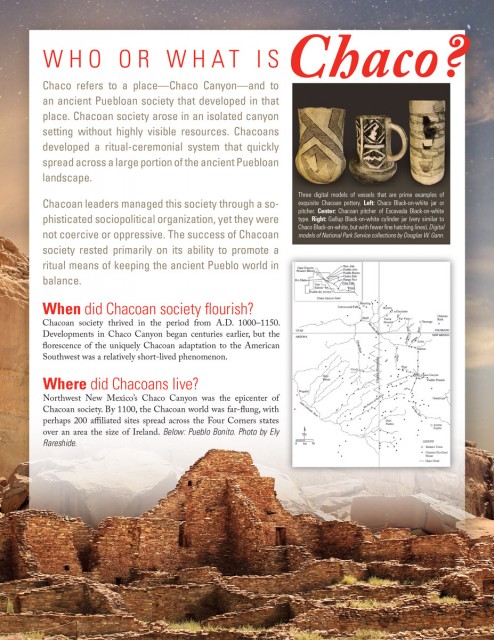
Chaco refers to a place—Chaco Canyon—and to an ancient Puebloan society that developed in that place. Chacoan society arose in an isolated canyon setting without highly visible resources. Chacoans developed ritual-ceremonial system that quickly spread across a large portion of the ancient Puebloan landscape.
Chacoan leaders managed this society through a sophisticated sociopolitical organization, yet they were not coercive or oppressive. The success of Chacoan society rested primarily on its ability to promote a ritual means of keeping the ancient Pueblo world in balance.
When did Chacoan society flourish?
Chacoan society thrived in the period from A.D. 1000–1150. Developments in Chaco Canyon began centuries earlier, but the florescence of the uniquely Chacoan adaptation to the American Southwest was a relatively short-lived phenomenon.
Where did Chacoans live?
Northwest New Mexico’s Chaco Canyon was the epicenter of Chacoan society. By 1100, the Chacoan world was far-flung, with perhaps 200 affiliated sites spread across the Four Corners states over an area the size of Ireland.
What do we know about Chacoan society?
Chacoans’ “calling-card” across the ancient landscape was their amazing architecture. They built large multistory dwellings known as great houses. Standing up to 50 feet high, with massive three-foot-thick walls, these buildings were visible for miles across the landscape. Great houses incorporated tens of thousands of carefully shaped, tabular sandstone slabs and hundreds of beams of high-elevation wood (pine, spruce, and fir) that had been carried dozens of miles overland from source areas in the mountains.
In addition to their immense great houses and great kivas, Chacoans engineered huge earthworks and hundreds of miles of roads across the ancient countryside. Beyond these engineering achievements, the Chacoans also constructed sophisticated astronomical features that enabled them to measure time and accurately track solstices, equinoxes, and lunar standstills. Chacoans were thus able to predict the movements of the sun, moon, and various stars and planets.
What are Chacoan outliers?
A key aspect of the Chacoan World was the network of affiliated sites spread across a large portion of the ancient Southwest. These “outlier” sites were highly variable, from ten-room sites such as Newcomb to large residential sites such as Salmon and Aztec Ruins. Chacoan migrants built some of these sites to serve as Chacoan colonies. Others were built at the behest of local Puebloan leaders who sought to be part of the Chacoan network.
Want to learn more? Explore the major concepts, places, cultures, and themes that Southwestern archaeologists are investigating today in our Introduction to Southwestern Archaeology.